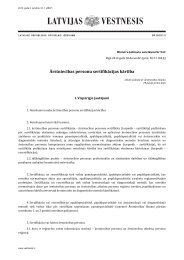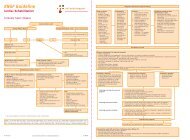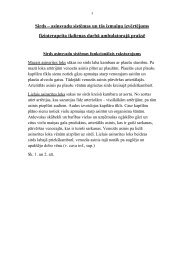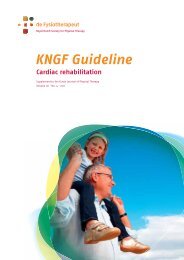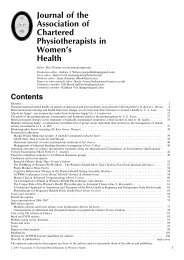Create successful ePaper yourself
Turn your PDF publications into a flip-book with our unique Google optimized e-Paper software.
<strong>Low</strong> <strong>Back</strong> <strong>Pain</strong>: Clinical Practice Guidelines<br />
CAT approaches to functional assessment theoretically allow<br />
for a test to more precisely depict functioning at the<br />
extremes of ability using the same outcome metric, though<br />
this assumes the IRT/CAT instrument has been subjected<br />
to rigorous testing, such as vetted item pool selection, accurate<br />
item calibration, and validated item-selection algorithms<br />
and scoring procedures. Future research is required to<br />
demonstrate further the advantages of IRT/CAT functional<br />
status outcomes measures versus more traditional self-report<br />
assessments.<br />
Whether using traditional assessments or IRT/CAT instruments,<br />
regular and accurate outcome assessment becomes<br />
of paramount importance in determining cost-effectiveness<br />
of care. When integrated with electronic health records<br />
software, capturing process of care and outcomes becomes<br />
a powerful tool in determining the value of care delivery.<br />
Combining process of care and outcomes that are important<br />
to the patient (eg, patient-centered care) the foundation for<br />
comparative effectiveness studies designed to assess which<br />
treatments are associated with better outcomes for each<br />
patient.<br />
Clinicians should use validated self-report question-<br />
A naires, such as the Oswestry Disability Index or the<br />
Roland-Morris Disability Questionnaire. These tools<br />
are useful for identifying a patient’s baseline status relative to<br />
pain, function, and disability and for monitoring a change in<br />
a patient’s status throughout the course of treatment.<br />
ACTIVITY LIMITATION AND PARTICIPATION<br />
RESTRICTION MEASURES<br />
There are instances where clinicians have to rely<br />
III on more than self-reported instruments in determining<br />
a person’s overall functional abilities as<br />
described in the ICF. This is especially true in decisions re-<br />
PHYSICAL IMPAIRMENT MEASURES<br />
Lumbar Active Range of Motion<br />
ICF category Measurement of impairment of body function – mobility of several joints<br />
a22 | april 2012 | volume 42 | number 4 | journal of orthopaedic & sports physical therapy<br />
garding activity limitations and participation restrictions (eg,<br />
return to work). There are a variety of tools used to assess<br />
functional capacity in a work setting. A systematic review was<br />
conducted by Gouttebarge and colleagues 129 on 4 commercially<br />
available Functional Capacity Evaluations: the Blankenship<br />
system, the ERGOS work simulator, the Ergo-Kit,<br />
and the Isernhagen work system, which identified 12 papers<br />
for inclusion. The interrater reliability and predictive validity<br />
of the Isernhagen work system were evaluated as good.<br />
However, the systematic review concluded that more rigorous<br />
studies were needed to demonstrate the reliability and<br />
the validity of Functional Capacity Evaluation methods.<br />
Schult and Ekholm268 compared the ICF core data<br />
sets for chronic widespread pain and low back<br />
pain58,59 with a work capacity assessment. They<br />
found that the work capacity assessment generally agreed<br />
with the comprehensive ICF core set representing body<br />
functions, body structures, activities and participation, and<br />
environmental factors. However, the authors concluded that<br />
both the work capacity assessment and ICF core data sets<br />
lacked the clinical analysis that could be obtained through<br />
an on-the-job site evaluation. 268<br />
III<br />
It would appear that in some instances when activity limitation<br />
and participation restriction are an expectation (eg,<br />
chronic low back pain), outcome assessment would need to<br />
be expanded from self-reported region-specific tools to include<br />
clinician-measured tools such as Functional Capacity<br />
Evaluations.<br />
Clinicians should routinely assess activity limita-<br />
F tion and participation restriction through validated<br />
performance-based measures. Changes in the patient’s<br />
level of activity limitation and participation restriction<br />
should be monitored with these same measures over the<br />
course of treatment.<br />
Description The amount of active lumbar flexion, extension, and side-bending motion measured using an inclinometer.<br />
Measurement method Inclinometers placed at the thoracolumbar junction and on the sacrum are zeroed with the patient in neutral. The patient is asked to<br />
bend forward maximally and motion is recorded at the thoracolumbar junction (total flexion measure) and at the sacrum, which is<br />
presumed to be motion in the sacroiliac and hip joints. The difference in motion represents the lumbar flexion measure. The patient is<br />
then asked to bend backward and the difference in motion is the lumbar extension measure. A similar process is used for side bending<br />
with the inclinometer aligned in the frontal plane, and the patient is asked to bend to each side.<br />
Nature of variable Continuous<br />
(continued)



